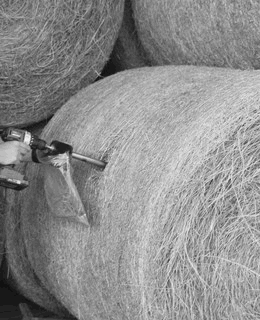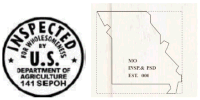

To send a message to an author, click on the author's name at the end of the article.
This Month in Ag Connection | Ag Connection - Other Issues Online
Many producers are concerned about hay quality, so a quick discussion on sampling techniques is warranted. Testing is necessary to accurately determine the feed value of hay. Accurate feed quality values are needed to effectively balance rations. Without a forage test, average hay quality values are used and may not accurately represent the forage.

To collect the sample, use a hay test corer to get a cross section of the bales being sampled. Hay corers can be used with either electric drills or hand braces. Sample round bales from the side, not from the end. It will take some pressure to get the corer pushed into the bale. Moisture and bale density will impact the force needed to push the corer into the bale. Get the corer as deep into the bale as possible. This ensures sampling a good cross section of the bale at various depths across the bale. Do not pull a handful of hay from the end of the bale as your sample. That will not give an accurate result.
As with sampling any product, the results will only be as good as the sample that is collected and sent to the laboratory. Sample 10 to 12 bales from each lot of hay that is being tested. A lot could be from a specific cutting, specific field, different forage species, etc. Collect samples from the entire pile or line of bales to ensure bales from various places in the field are being sampled. Avoid taking a round bale or flake of hay to the Extension office for sampling because it is not a representative sample.
All samples collected from a lot of hay can be put into the same container or freezer bag. Quart size freezer bags filled about 2/3 full should provide enough hay for the lab. Once the sample has been collected and placed in the freezer bag, mark the bag with details including name and sample identification.
Many commercial labs provide forage analysis services. Each of these labs will have a form to submit along with the sample. Fill out the form carefully. Include information about the sample, such as cool-season grass hay, grass legume mixed hay, warm-season grass hay, legume haylage, etc. Some labs also request the species of animal being fed.
Labs offer a variety of tests, therefore, selecting which test to run is the last decision. If it is a common forage, a test that provides information on protein, energy and a few major minerals is generally adequate. For a few dollars more, a more extensive test with additional information on fiber analysis and trace minerals may be warranted. Test packages and costs vary from lab to lab, but generally range from $20 to $35 depending on the analysis being requested.
Most MU Extension offices have hay probes or at least access to this equipment. Many will have information and submission forms from several labs. Submission forms and fees are also available from laboratory websites.
If you have additional questions on hay testing, collecting, or submitting samples, contact your local MU Extension Center. Hay testing is not hard, but the information is only as useful as the sample collected and analysis requested.
Source: Gene Schmitz, Livestock Specialist
This Month in Ag Connection | Ag Connection - Other Issues Online
This article is a continuation from last month (July issue)
The next items fall under the perview of the Missouri Department of Agriculture, but different divisions.
Eggs
An egg license is needed to sell eggs. These are issued for one year and are effective from July 1 through June 30. While there are four types of licenses, the most common one for farmers' market vendors is the R2 described below.

Types of Egg licenses:
Licensed egg producers are subject to inspection to insure eggs are clean and undamaged; are being stored at 45°F or below; are correctly labeled with size, grade, pack date, and packer/grader name and address. If using recycled cartons, the carton must be sound, clean, and free of dirt and all information pertaining to the eggs inside must be accurate according to how they are currently being sold.

Meat and Poultry
All individuals selling meat or poultry in Missouri must be registered with the Meat and Poultry Inspection Program. When offered for sale, it must bear "Mark of Inspection" or be processed under an exemption. For example, if a producer sells the live animal to someone then delivers it for processing, this can be done under "Custom Exempt". For poultry, there is an exemption for less than 1,000 birds per calendar year, and in rare instances, an exemption may be granted for less than 20,000 birds per calendar year. Label may bear ''Exempted- P.L. 90-492''. Rabbits also have an exemption for less than 1,000 head per calendar year.

Scales
Vendors selling by weight at the market need approved scales. Scales should be certified by Missouri Department of Agriculture (MDA) once a year for a standard period from July to June. Oftentimes, a market will coordinate a date when vendors bring their scales to a set location to meet with a certifier. Devices used in commercial trade must be NTEP (National Type Evaluation Program) approved and "Legal for Trade". Consider scale styles and sizes to ensure it meets the capacity needed based on volume and type of product.
Farmers' market, sales and use tax exemption (RSMo.144.527.1)
There shall also be specifically exempted from state and local sales and use taxes defined, levied, or calculated, all sales of farm products sold at a farmers' market.
For purposes of this section "farm products" shall mean any fresh fruits, vegetables, mushrooms, nuts, shell eggs, honey or other bee products, maple syrup or maple sugar, flowers, nursery stock and other horticultural commodities, livestock food products, including meat, milk, cheese, and other dairy products, food products of aquaculture including fish, oysters, clams, mussels, and other molluscan shellfish taken from the waters of the state, products from any tree, vine, or plant and other flowers, or any of the products listed in this subsection that have been processed by the participating farmer, including, but not limited to, baked goods.
For purposes of this section "farmers' market" shall mean an individual farmer or a cooperative or nonprofit enterprise or association that consistently occupies a given site throughout the season, which operates principally as a common marketplace for an individual farmer or a group of farmers to sell farm products directly to consumers, and where the products sold are produced by the participating farmers with the sole intent and purpose of generating a portion of household income.
The fourth criteria, other than product, single location, and made by the producer, is the annual sales cap, If all the above criteria are met, then a producer can sell up to $25,000 per year in direct sales without needing to pay sales tax.
As an ending consideration, consult with both the local health department and farmers' market manager. Some counties and cities have health ordinances stricter than the state. Most markets have guidelines for vendors which often vary from market to market.
Source: Darla Campbell, Business & Community Specialist
This Month in Ag Connection | Ag Connection - Other Issues Online
Winter feed accounts for a large part of a cattle producer's costs. Grazing stockpiled forages during the winter may reduce feed costs significantly. Stockpiled forages provide high quality feed in late autumn and winter.
Mindful selection of the pastures to stockpile is important. Tall fescue is the most common forage stockpiled for winter grazing. The upright growth pattern and waxy coating on the leaves make tall fescue more tolerant of cold temperatures than other cool season grasses. Choose pastures which are relatively weed free. Weeds, especially broadleaf weeds, break up the canopy. This allows cold temperatures to penetrate deeper into the canopy earlier in the season.
Prepare pastures to be stockpiled in late summer by grazing or mowing the forage to a four-inch stubble height and apply nitrogen fertilizer by mid-August. This allows enough time for maximum forage growth before winter without sacrificing forage quality. On average, tall fescue will produce approximately 20 pounds of dry matter for every pound of nitrogen fertilizer applied in August. Yield can be much higher when moisture is not limiting.
Ammonium nitrate or polymer coated urea are the best sources of nitrogen to apply. Untreated urea fertilizer could be lost due to volatilization without adequate rainfall immediately after application. This makes it a less desirable fertilizer choice, especially when temperatures are warm. Ammonium sulfate fertilizer is also effective.
The quality and quantity of the forage available will decline as the winter progresses. Wet weather hastens the decline over time. Graze heavily fertilized stands early. If grazing is deferred later than January, the risk of dry matter loss associated with freezing, thawing, and death of the leaves is too great to justify nitrogen fertilization rates greater than 50 pounds per acre.
Results of a study conducted at the MU Forage Systems Research Center indicate the presence of red clover does not affect total stockpile yield, but does improve crude protein levels of the total forage available when nitrogen fertilization rates are 50 pounds per acre or less. Applying more than 50 pounds of nitrogen per acre will increase the ergovaline content (the toxin) of endophyte infected tall fescue above safe levels in autumn and will have a negative impact on the red clover stand the following season.
Forage utilization can be increased by implementing strip grazing. Start grazing close to the water source and progressively provide more pasture to the animals every three to seven days. Cattle can readily graze stockpiled forages through three or four inches of snow, but a quarter inch of ice can be detrimental to grazing.
Source: Valerie Tate, Agronomy Specialist
This Month in Ag Connection | Ag Connection - Other Issues Online
Missouri State Fair
Aug. 8 - 18
mostatefair.com
This Month in Ag Connection | Ag Connection - Other Issues Online
For the past twenty years, MU Extension Agricultural Business and Policy (ag economics) team has been conducting the Missouri Farmland Values Opinion Survey annually. The data is summarized and used to update MU guide 401 on farmland values.
The summarized results are used for insights into land value trends for cropland, pastureland, timberland and recreational or hunting land. Farmers, lenders and others use the data to make informed decisions.
The survey opened July 1st and will remain open through August 15th. The survey is for those who have firsthand knowledge of farmland sales including buyers, sellers, lenders, appraisers, etc.
The survey can be completed:
1.)online at muext.us/landvaluesurvey24
or
2.)via paper survey available at county extension centers. Paper copies can be requested by calling 573-581-3231 then a paper survey will be mailed to you.
This Month in Ag Connection | Ag Connection - Other Issues Online
Applications are being accepted for the Missouri Climate-Resilient Crop and Livestock (CRCL) Project. The incentive payment programs for farmers to implement climate-smart practices are reopening! These programs are available through the Missouri Climate-Resilient Crop and Livestock (CRCL) Project, funded by a $25 million USDA Partnerships for Climate-smart Commodities grant. Sign-up periods are:
August 1, 2024 opens
Nutrient Management and 4R Approach: $20 per acre
November 1, 2024 opens
Regenerative Grazing: $50 per acre
Climate-Smart Fieldscapes: $10,000 spread across a 3-year contract
There are more details to each of these programs. Check the following website for ending dates and details - https://cra.missouri.edu/mo-crcl/ or e-mail kellyrwilson@missouri.edu.
Publishing Information
Ag Connection is published monthly for Northeast and Central areas of Missouri producers and is supported by the University of Missouri Extension, the Missouri Agricultural Experiment Station, and the MU College of Agriculture, Food and Natural Resources. Managing Editor: Mary Sobba.